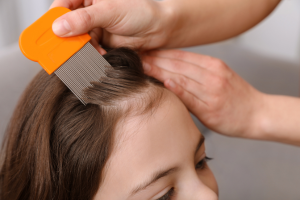As the 2023-2024 school year begins, we want to ensure parents are informed about lice in children. It’s important to note that head lice is a common issue, particularly among school-aged children. Lice is diagnosed by observing either lice or lice eggs (nits) on a person’s body or hair and is easily transmitted from person to person or from clothing, bedding, and brushes.

DEFINITION:
A parasite that lives on the human body
SYMPTOMS:
Itching wherever the lice are located
CAUSES:
· Pediculus humanus corporus (body lice) on the body
· Pediculus humanus capitis (head lice) on the head
· Phthius pubus (crabs) in the pubic area
CONTAGION:
Lice are transmitted from person to person contact or from clothing, bed sheets, combs, brushes, or other items containing the louse.
DIAGNOSIS:
Lice is diagnosed by observing either lice or lice eggs (nits) on a person’s body or hair. Body and pubic lice are treated with permethrin (Nix, Elimite) or lindane (Kwell) cream, and washing all clothing in hot water or placing them in a bag for two weeks to prevent transmission. Head lice are treated with permethrin cream (NIX, Elimite), permethrin pyrethroid shampoo (RID, A-200), or lindane shampoo (Kwell). Lindane is not used in neonates (newborns) due to its potential toxicity in that age group. Also, nits or eggs should be removed as much as possible with a nit comb. Treatment should be done once and then repeated in two weeks. Head lice can be very resistant, and alternative treatments may be necessary. These include:
- Vaseline on the head to suffocate the lice or nits
- Vinegar water rinse to remove the nits
- 8% formic acid rinse to remove the nits
- Ivermectin (an oral antiparasite drug) to kill the lice and nits
- Malathion cream (Ovide) to kill lice and nits
- Trimethoprim/ sulfa (Bactrim/Spectra), which is an antibiotic that will kill organisms in the lice’s stomach, thereby preventing its ability to digest food
OUTCOME:
Excellent with treatment
DISCUSSION:
Lice can only live long-term on the human body. They can survive on clothing or furniture for up to one month. Treatment is essential to rid the initial person of the infestation and prevent its transmission. Mainly, permethrin (Nix, Elimite) is used since it is the least toxic and will work most of the time. Head lice can be more complex, and alternative treatment is frequently necessary. Lice will usually lay their eggs, and the eggs or nits will attach with an almost superglue strength to the hair shaft within three to four millimeters of the scalp. If the nits are further than one centimeter from the scalp, then live lice will not be inside the nit. At this point, the child would not be contagious. Most schools have a policy that all nits must be removed for the child to return to school. However, this is not a contagious illness once the nits are greater than a centimeter from the scalp. Lice cannot survive at that distance from its source of nutrition: capillaries containing blood on the scalp. For some children with thick hair, it is nearly impossible to remove all the nits, and sometimes only shaving all of the hair off the head will resolve this problem. Schools should become educated as to what truly constitutes a contagious illness.
ONE DOCTOR’S OPINION:
Lice and nits are easy to see on the body or hair. Head lice are becoming resistant to some drugs and are more challenging to eradicate. All the nits within three to four millimeters of the scalp must be removed, or new lice will soon appear. Greater than one centimeter, and it is not a concern. I like the LiceMeister comb to remove the nits. Sometimes, people with a thick head of hair will have difficulty, and alternate therapy may be necessary. This illness is not caused by poor hygiene, malnourishment, or sanitary conditions. It is just an illness that is passed from person-to-person very easily.
This blog was written by Dr. Michael Bornstein, who has 30 years of experience as a pediatrician.
Disclaimer: The contents of this article, including text and images, are for informational purposes only and do not constitute a medical service. Always seek the advice of a physician or other qualified health professional for medical advice, diagnosis, and treatment.


FOLLOW US